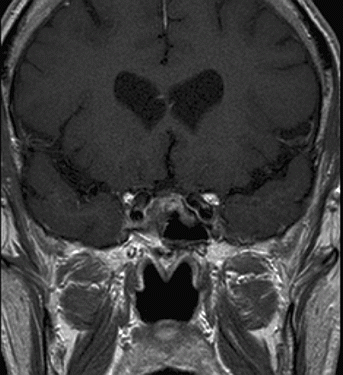SFEBES2012 Poster Presentations Pituitary (43 abstracts)
Autoimmune hypothyroidism coexisting with a TSH secreting pituitary adenoma
Rashmi Manjunatha & Darren Warner
Diabetes and Endocrinology, Princess Royal Hospital, Telford, United Kingdom.
Case: A 62-year old man with a previous diagnosis of asymptomatic subclinical hypothyroidism (TSH: 13.6 mU/L, FT4: 23 pmol/L) and elevated TPO antibody titres (>600 IU/ml) was referred with persistently elevated TSH levels despite increments in the dose of thyroxine. Thyroid function test (TFT) on 200 mcg of thyroxine showed an elevated TSH (13.0 mu/L) and FT4 (31.1 pmol/L). Thyroxine was gradually reduced and stopped. Following this, although FT4 levels normalised (20.7 pmol/L), TSH continued to remain elevated (21 mU/L). TSH alpha-subunit came back as elevated at 5.90 IU/L (normal <1.00 IU/L) raising a suspicion of TSH producing pituitary adenoma. MRI pituitary confirmed a 2 cm mass replacing much of the pituitary with no compression on the optic chiasm. Visual fields were normal. Rest of the static pituitary profile and short synacthen test were normal. The patient underwent hypophysectomy which resulted in normalization of TFT (TSH 2.88 mU/l, FT4 13 pmol/L). Post operatively, he was started on testogel and did not require any other hormone replacement. Post operative MRI showed a 50% reduction of the tumour. Histology revealed scattered cell stain for growth hormone along with light staining for TSH. Roughly a year after hypophysectomy, TFT revealed an elevated TSH (18.1 mU/L) with a low FT4 level (8.9 pmol/L) indicating primary hypothyroidism. Thyroxine was started, the dose of which was gradually increased to 125 mcg which eventually normalized the TSH level to 4.0 mU/L. Discussion: TSH levels in patients with TSH-oma and intact thyroid may be elevated or normal, whereas total and free thyroid hormone levels are definitely high. Our case was unusual in that the FT4 levels were normal with an elevated TSH at the time of initial presentation indicating an underlying autoimmune hypothyroidism which masked the biochemical picture of a TSH secreting pituitary adenoma. Hypothyroidism is likely to have protected the patient from the thyrotoxic effects of the TSH-oma.
Conclusion: This case highlights the fact that exploring the possibility of a TSH-oma is indicated in patients with hypothyroidism and persistently elevated TSH levels in the context of elevated FT4 levels on thyroxine replacement.
Declaration of interest: There is no conflict of interest that could be perceived as prejudicing the impartiality of the research reported.

Funding: No specific grant from any funding agency in the public, commercial or not-for-profit sector.
 }
}



